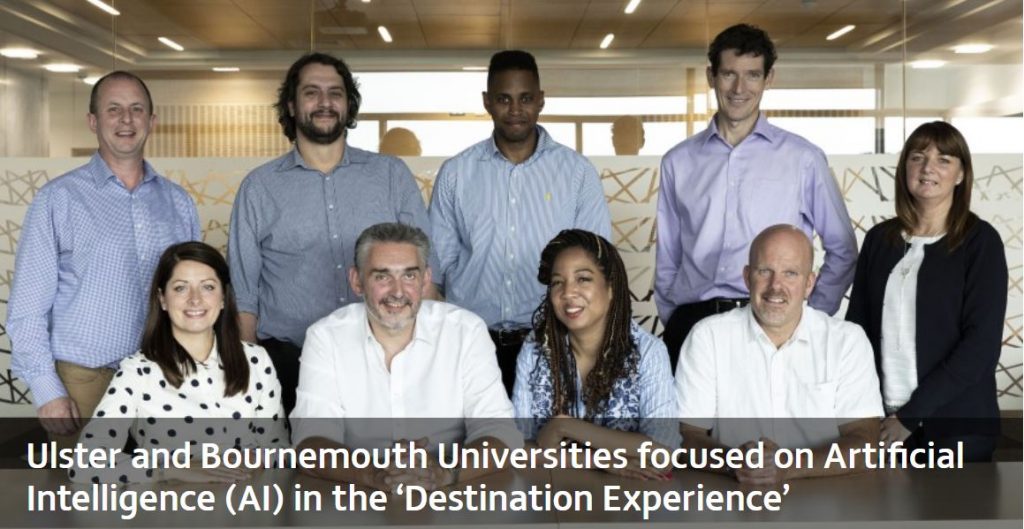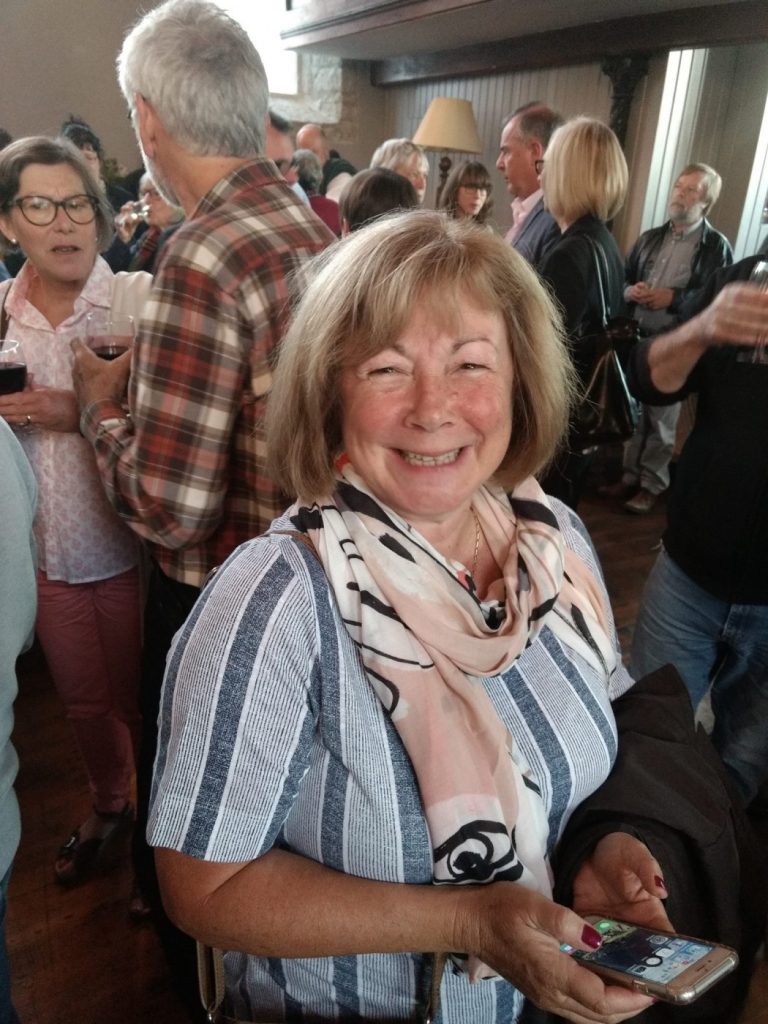
BU Researcher presents at UK National Earth Observation Conference 2018

Latest research and knowledge exchange news at Bournemouth University

The Department of Events and Leisure (DEL) has a long-standing tradition of contributing their expertise to events and festival organisations throughout the UK. This event/festival season has been exceptionally busy for DEL and has seen staff collaborating with organisations in Northern Ireland, London and in Dorset.

Dr Nicole Ferdinand ( front row, third from left) at project update meeting at Ulster University attended by Fergus Mckay, Operations Manager, International NW200 (back row, 1st from left)
Dr Nicole Ferdinand, Senior Academic in Events Management through a collaborative research project with Ulster University is currently working with the International NW200. Fergus Mckay, Operations Director has been extremely positive about the results of the project so far and the value it has delivered for his organisation. At a project update meeting hosted on August 24, 2018, he provided the following feedback:
“The collaboration with Ulster University and Bournemouth University has enabled us to investigate technology enabled means to create accessible, real-time and personalised event experiences both at the event and throughout our fans visit to the area. Looking for fun and unique experiences for event participants is a critical event objective and the recent twitter bot was a means by which to create and share fun experiences.”
Dr Aaron Yankholmes, VIP at Notting Hill Carnival 2018
Dr Aaron Yankholmes, Academic in Events and Leisure was a VIP at the Notting Hill Carnival on bank holiday Monday August 27th, 2018. He was specially invited by the organising committee to the celebrations this year. DEL staff have a long history with the organization, having collaborated with NHC stakeholders on a research informed strategic visioning project in 2013 entitled Carnival Futures. DEL staff have also published a number of articles and case studies on this event. This year was first time that the organisation has hosted a DEL member of staff at their event.

Dr Caroline Jackson at B-Side Festival Launch
Dr Caroline Jackson and Dr Nicole Ferdinand were also VIP guests at the B-side Festival opening. Dr Ferdinand has also joined the B-side Festival Board of Directors with a view to supporting B-side with implementing a programme of institutional strengthening activities supported by their recently awarded Arts Council Catalyst Fund.
The 45th International Conference & Exhibition on Computer Graphics and Interactive Techniques (SIGGRAPH’18), the international annual conference of the Special Interest Group on Computer Graphics and Interactive Techniques of the Association for Computing Machinery (ACM, the world’s foremost computing society) was held in Vancouver in August.
Among the work showcased at the conference was the poster “Withering fruits: vegetable matter decay and fungus growth” by Bianca Cirdei (Computer Visualisation and Animation – CVA, Level 6) from this year’s graduating cohort from the National Centre for Computer Animation (NCCA, Faculty of Media and Communication) and co-authored by Dr Eike Falk Anderson.

The work, which was based on Bianca’s Innovations Project unit results extends and improves existing methods for procedurally simulating decaying fruit for use in computer graphics and visual effects, focusing on artist directability and visual fidelity. As the resulting visuals are quite impressive, this project was also one of the ten submissions featured in the SIGGRAPH’18 posters preview video.
Of the 74 posters presented at this year’s SIGGRAPH conference, 16 submitted posters, including Bianca’s contribution (poster 74), were invited to the first round of the prestigious ACM Student Research Competition (SRC) sponsored by Microsoft. Bianca’s submission was one of only four European semi-finalists and of those the only one from a UK institution. After presenting the work to a panel of experts, the submission made it into the second round and after the ACM Student Research Competition Final Presentation it won first place in the undergraduate category.
After Ben Knowles (with Dr Oleg Fryazinov) who was awarded second place at SIGGRAPH’15 for “Increasing realism of animated grass in real-time game environments“, Teemu Lindborg and Philip Gifford (with Dr Oleg Fryazinov) who were semi-finalists at SIGGRAPH’17 for “Interactive parameterised heterogeneous 3D modelling with signed distance fields” and Quentin Corker-Marin (with Dr Valery Adzhiev and Professor Alexander Pasko) who achieved second place at SIGGRAPH’17 for “Space-time cubification of artistic shapes“, this is the first time that an NCCA student has won first place in this prestigious competition.
The work will now progress to the next stage of the competition, the Grand Finals in 2019, in which the first placed entries from almost 30 major ACM conferences will compete with one another.
Dr. Kevin Larson of Microsoft has agreed to give a talk on interdisciplinary research as part of his visit to the UK at Bournemouth University. For those who would be interested in attending, please contact Daniela Doncakova (ddoncakova@bournemouth.ac.uk<mailto:ddoncakova@bournemouth.ac.uk>) to arrange a place at this lecture. The event will take place on 26/9/18 from 15:00.

The Department of Health and Human Services at the National Institutes of Health has announced a funding opportunity to provide a mechanism of support to research organizations interested in clinically translating already optimized quantitative imaging software tools capable of measuring or predicting the response of cancer to clinical therapies, or in translating imaging software tools for planning and validating radiation therapy treatment strategies in clinical trials. The proposed research effort should be an extension of the research that successfully completed the tasks of developing and optimizing the chosen software tools or data collection methods intended to facilitate clinical decision making during clinical trials.
Summary :
Call opens : 5 January 2019
Call deadline : 5 February 2019
Award available : All direct costs not exceeding $500,000 each proposed year
Project duration : 5 years
Please see this link for more information.

The Innovator Awards support researchers who are transforming great ideas into digital healthcare innovations that could have a significant impact on human health. Individuals and teams from not-for-profit and commercial organisations can apply. Organisations can be of any size, based anywhere in the world.
Researchers working in any discipline and on any type of digital technology can apply. Examples of digital technologies include:
Projects must be innovative, disruptive and address an unmet healthcare need or challenge.
Summary :
Call opens : 1 October 2018
Call closes : 3 December 2018
Available funding : between £500,000 and £1million
Project duration : up to 2 years
Please see this link for more information about this call.

The Global Innovation Linkages program from the Australian Government provides Australian businesses and researchers with matched funding of up to $1 million per project to collaborate with global partners on strategically focused, leading-edge research and development.
To be an eligible lead organisation you must:
Project partners must include at least:
Summary :
Application deadline : 14 November 2018
Available funding : up to $1million per project
Grant period : Maximum four years
Please see this link for more information about this call.

This Small Business Research Initiative (SBRI) competition is funded by the GovTech Catalyst and is sponsored by Durham County Council and Blaenau Gwent County Borough Council.
This competition looks at 2 specific data-gathering techniques in local council services:
1.‘Boots on the ground’: enabling residents to collect and report accurate data about public assets, such as potholes and street lighting, to the local council.
2.‘Eyes on the street’: using local council vehicles to collect and report data as they travel around the borough.
Summary :
Call opens : 24 September 2018
Call closes : 31 October 2018
Available funding : up to £50,000 (including VAT)
Project start date : by 7 Feb 2019
Please see this link for more information about this call.
As part of the government’s Clean Growth Strategy BEIS has allocated up to £20 million to design and construct carbon capture and utilisation (CCU) demonstration projects. This programme is designed to encourage industrial sites to capture carbon dioxide which could then be used in industrial applications, while enabling learning and development of capture technologies at an intermediate scale, so reducing costs and risks.
The overall aims of the CCU demonstration programme are:
The programme is in 3 phases:
Summary :
Call closes : 11 November 2018 (Applicants must complete the application forms on this link and submit by email to Industry.Innovation@beis.gov.uk by Sunday 11 November 2018.)
Available funding : up to £5million
Project duration : up to 24 months
Project dates : finish by 31 March 2021
Please see this link for more information about this call.
Up to £20million investment will be made by Innovate UK in the best cutting-edge or disruptive ideas with a view to commercialisation.
All proposals must be business focused, and can come from any area of technology, science or engineering, including arts, design, media or creative industries.
Summary :
Call opens : 24 September 2018
Call closes : 14 November 2018
Available funding : between £25,000 and £500,000
Project duration : Between 19 and 36 months
Project dates : start by 1 April 2019 and end by 1 April 2022
Please see this link for more information about this call.
UK organisations can apply for a share of up to £8 million to carry out collaborative R&D, collaborative fast-track and feasibility projects that enhance the UK’s position in civil aerospace.
To be eligible for funding you must:
To lead a project you must:
To collaborate you must be a:
Summary :
Call opens : 24 September 2018
Call closes : 5 December 2018
Available funding : between £425,000 to £1million
Project duration : Between 12 and 24 months
Project dates : start by August 2019 and end by August 2021
Please see this link for more information about this call.
Up to £4million is available for UK businesses to apply for to research and develop technologies that accelerate the transition to zero emmision vehicles.
To be eligible you must:
To lead a project you must be a UK based business, of any size.
A separate £2 million is available for feasibility study projects and a further £16 million to support proportionality smaller collaborative R&D projects.
Summary :
Call closes : 6 December 2018
Available funding : up to £4million
Project duration : Between 12 and 36 months
Project dates : start by June 2019 and end by June 2022
Please see this link for more information about this call.

The Defense Advanced Research Projects Agency (DARPA) Defense Sciences Office (DSO) has issued a Disruption Opportunity (DO) Special Notice (SN) inviting submissions of innovative basic or applied research concepts in the technical domain of artificial intelligence and game theory. In particular, DARPA is interested in understanding the feasibility of applying recent developments in these areas to complex military decision making in changing multi-agent environments with imperfect information.
Please see below a summary of this funding opportunity:
Available funding: Phase 1 (Feasibility Study) – $500,000; Phase 2 (Proof of Concept) – $500,000
Award duration : Phase 1 – 8 months; Phase 2 – 10 months
Deadline for submission : 16 October 2018
Please see this link for more information about this funding call.

There are currently two calls available under the Policy Research Programme offered by the NIHR.
Call 1 : Infectious Disease Dynamic Modelling in Health Protection Call
The National Institute for Health Research Policy Research Programme (NIHR PRP) invites applications for the call: Infectious Disease Dynamic Modelling in Health Protection to address two key areas:
This programme will provide a responsive dynamic resource to augment the analytical support currently provided within the Department of Health and Social Care (DHSC) and PHE, which contributes towards the development of infectious disease and immunisation.
Submission Deadline : 2 October 2018 (Stage 1); 22 January 2019 (Stage 2)
Submission outcome : December 2018 (Stage 1); May 2019 (Stage 2)
The National Institute for Health Research (NIHR) Policy Research Programme (PRP) invites applications to undertake health inequalities research for the call: Health Inequalities Research Initiative to support policy makers in the Department of Health and Social Care (DHSC) in the following areas:
Submission Deadline : 2 October 2018 (Stage 1); 22 January 2019 (Stage 2)
Submission outcome : December 2018 (Stage 1); May 2019 (Stage 2)
Please see this link for more information about this call.

Maurizio Borghi, Bournemouth University
The new European Union Copyright Directive, passed recently by the European parliament after a vociferous campaign both for and against, has been described by its advocates as Europe striking a blow against US tech giants in the battle for control of copyrighted content online. This is painted as a battle about who pays for creative works, culture, and the role and workings of a free press in a world where these “commodities” are exchanged freely on social media and other platforms controlled by giants such as Google and Facebook.
The sense of this battle is found in two articles from the text of the new directive. Article 11 introduces the “press publishers’ right”, also called the “link tax”. This permits publishing groups such as newspapers and other media to charge online content sharing service providers and platforms – most obviously, Google, Facebook and Twitter – a fee for a licence to link to their content. Article 13 makes online content sharing service providers responsible for the copyright content uploaded by users. Large platforms must implement filters to monitor copyright infringements and obtain licences from music, film and television rights-holders for the use of copyright content where it appears on their services – YouTube and Instagram, for example. This has led to claims that the directive would effectively ban memes, because automated checking of uploads would identify them only as copyright material, rather than allowable “fair use” or “parody”.
Unsurprisingly, publishers and copyright industries across Europe have saluted the new law as a great victory of European culture and free press against the greedy American titans. But it is not this simple.
When companies like Google and Facebook started their ascent as global players in the mid-2000s, they benefited from a generally favourable legislative framework, made of legislative vacuum and liberal legislation. Thanks to the flexible contours of the “safe harbour” provisions for internet hosting services – which essentially immunises them from any liability for content uploaded by their users – YouTube rapidly became the main channel of distribution of music. Similarly, Facebook and Google News became major distributors of news (whether good, bad or “fake”).
The ascent of these companies was not without hurdles and challenges, including a chequered history of lawsuits from music, film and television companies against content-sharing platforms, and by press publishers against news aggregators, which eventually changed the legal contours of the hosting providers’ safe harbour in the European Union. As a result of these legal disputes, the tech firms have progressively adapted their business models from head-on challenge of copyright norms to adopting a more accommodating attitude towards copyright holders and press publishers.
Google, for example, has entered into various commercial agreements with news agencies and publishers to display content in Google News and Google Books. YouTube, a Google subsidiary, has entered into revenue-sharing agreements with copyright holders based on a technology called Content ID that detects, identifies and manages copyright-protected music and video uploaded by users. Facebook has struck similar deals with major music labels and has a partnership programme with news publishers. A large amount of the content we consume today through these platforms is authorised by the copyright owners and generates some revenue for them.

So in this respect, what the new EU Copyright Directive now obliges the tech giants to do is largely what they do already. To be sure, it is an open question whether they pay enough for the privilege of making use of (and profiting from) all that content created by others. Admittedly, by obliging tech giants to pay press publishers and to obtain licences with copyright holders, the new directive may reduce their bargaining power with respect to the arrangements they must make with content creators, and therefore lead the copyright holders to increase their revenue share. This small (and largely uncertain) effect has some important consequences.
Take the directive’s article 13, which redefines the safe harbour for content-sharing providers. In effect, platforms like YouTube will be directly responsible for copyright content uploaded by their users (although they will continue to be shielded from direct liability for other wrongs committed by their users, such as defamation or hate speech). If this norm was in place ten or 15 years ago it would have prevented YouTube from becoming what it is today.
But now it is only good news for YouTube. The new directive will have little effect on its current business model (perhaps paying only a little more for contracts with copyright owners), but it will prevent others from challenging established firms’ dominant positions. Costs that for platforms like YouTube or Instagram today represent a small and ultimately insignificant portion of their profits are huge and potentially insurmountable barriers for new companies attempting to enter the market.
Only micro or small enterprises and non-commercial platforms – which are excluded from the effects of article 13 – will benefit from the same favourable legislative conditions that Facebook and Google experienced at the beginning of their career. But even these, as soon as they become more than start-ups, will have to operate in the same playing field as established giants – leaving them with no serious prospect of winning a substantial market share, challenging their dominance, or providing an outlet for innovation.
Quite the opposite from what was the intention, the Copyright Directive may ensure the current crop of tech giants retain their dominant position for a long time, possibly forever. Which one could say is not exactly bad news for them, and not exactly a victory for European creativity either.
Maurizio Borghi, Professor of Law, Bournemouth University
This article is republished from The Conversation under a Creative Commons license. Read the original article.
 BU has an agreement with Springer which enables its authors to publish articles open access in one of the Springer Open Choice journals at no additional cost.
BU has an agreement with Springer which enables its authors to publish articles open access in one of the Springer Open Choice journals at no additional cost.
There are hundreds of titles included in this agreement, some of which are – Hydrobiologia, European Journal of Nutrition, Annals of Biomedical Engineering, Climatic Change, Marine Biology and the Journal of Business Ethics. A full list of the journals included can be found here
To make sure that your article is covered by this new agreement, when your article has been accepted for publication, Springer will ask you to confirm the following:
Springer will then verify these details with us and then your article will be made available in open access with a CC BY licence.
Please note that 30 Open Choice journals are not included in this agreement as they do not offer CC BY licensing.
If you have any questions about the agreement or the process, please contact OpenAccess@bournemouth.ac.uk

Just over two years ago, I went to San Francisco to launch my book Pedro Zamora, Sexuality and AIDS Education, at the GLBT Historical Society. Just two days ago I came back from New York where I launched my latest book Heroism, Celebrity and Therapy in Nurse Jackie. While this seems like a roller coaster of production and travelling (with a lot of it all at my own expense!), in thinking about these two events, I was struck by the meaning of ‘place’ in research.
When I was in San Francisco, I was fortunate to not only be interviewed by the Bay Area Reporter, but also Alastair Gee interviewed me (who often writes in in the Guardian and The New Yorker). Alastair and I were in conversation for over two hours – outside the ‘Real World’ house – the place where Pedro Zamora had lived whilst filming the TV series, shortly before he died. Alastair mostly pressed me to explain my interest and connection with that particular location – ‘The Real World House’ – on Lombard Street, the most ‘crooked’ (winding) street in the world. The interview seemed more like a therapy session, where we also discussed the tragic event of the Orlando shooting incident that had occurred at Pulse Nightclub – just a few days before, where 49 people attracted to and/or part of the LGBT community were slain. Whilst Alastair didn’t eventually transform this interview into a published piece, this memory of the interview and the possible meaning of a particular place- relevant to research – still kind of ‘haunts me’.
Spin forward two years, and somehow, I am revisiting the notion of ‘place’, as I decided to launch my new book at the BGSQD bookshop, just a few yards from the now demolished St. Vincent’s hospital in Greenwich Village, New York. The reason for this was simple, in the book I hypothesize that the fictional hospital of ‘All Saints’ in Nurse Jackie was potentially inspired by ‘St Vincent’s’. This is not difficult to work out, as St Vincent’s was sold off after going bankrupt just a few years back, and then converted into luxury condominiums. Nurse Jackie references this, by ending the series with the closing of the fictional ‘All Saints’ hospital, where our (anti) heroine Jackie Peyton passes away just after the last patient leaves the building. Added to this Edie Falco the phenomenal actress who plays Nurse Jackie is a resident of New York, I believe living not that far from Greenwich Village.
So where does this leave us? I think as researchers we are haunted by notions of place, not only where we fit in the research, but where the research narrative is played out. Being near a place where there might be some emotional meaning in the research, connects us to our human condition. For me getting the chance to be near St. Vincent’s (or should I say where it used to be), was very moving indeed. Not only was this potentially the inspiration for the setting of Nurse Jackie (a wonderful story of morality, humanity and fallibility, by the way) but coincidentally St Vincent’s was the hospital that cared for Pedro Zamora not long before he passed way.
The original buildings may be gone, in the case of ‘the Real World house’ transformed into flats, and in the case of St. Vincent’s demolished and the space transformed into something quite different, no longer a life blood to support deprived community, everyday people and outsiders. As Tom Eubanks reports in his book ‘Ghosts of St. Vincent’s’: ‘Before the entitled lived here exclusively, the marginalized died in droves’. St. Vincent’s was not only the place where those who were dying of HIV/AIDS (in the early years of the syndrome) were cared for, when many didn’t care or were too scared, but also when the Twin Towers were attached on 9/11, this was the place of first response in caring for the wounded, it was central in caring for community.
After the book launch I wandered around the streets of St Vincent’s, occasionally catching a glimpse of the cathedral-like ‘Freedom Tower’ (the new World Trade Center), a powerful sense of absence pervades in our knowledge of the original towers and the media coverage of their collapse.
Place seems significant, not only in thinking about what it all meant, but also where to go next. Research in some ways is distanced from ‘actual place’ as we try to create a perspective that seems unbiased; this is often something we tell students. However, in many ways meaningful research is situated deeply within us, it’s part of our emotional universe, occasionally illuminating the possible places that we might go, or be drawn to.

Luciana Esteves, Bournemouth University
We are all too familiar with images of flooding in low lying areas after heavy rainfall or houses destroyed by coastal erosion after a storm. For an increasing number of people, coastal flooding and erosion is a real threat to property, the local economy and, in some cases, life. Hurricane Florence, for example, is forcing more than a million people on the US East Coast to flee from their homes.
Coasts support important industries (such as ports and tourism) and their populations are growing faster than inland areas. But coastal areas are also particularly sensitive to impacts of climate change, which are likely to increase the extent, intensity and frequency of coastal flooding and erosion.
So not only have we occupied areas that naturally flood and erode from time to time, we have changed the environment in ways that increase coastal flooding and erosion risk. And we continue to do so, sometimes with serious legal consequences. Meanwhile, public policies have not been very effective in managing this predicament.
Traditional hard engineering approaches of coastal protection (such as groynes, revetments and seawalls) are known to cause detrimental effects, which in the longer term can aggravate the problem they were supposed to solve. The impact of Hurricane Katrina in New Orleans was a stark reminder that engineering structures are not effective against all events at all times. They are built based on trade-offs between the level of protection needed and the costs of construction and maintenance.
Soft engineering, such as beach nourishment (where sediment, usually sand, is added to the shore), can offer a level of protection and beach amenity – but these reduce through time, as erosion continues. Meanwhile, “protection” gives a false sense of safety and enables occupation of risk areas, increasing the number of people and assets in risk areas.

Climate change has forced a paradigm shift in the way coastal flooding and erosion risks are managed. In areas of lower risk, adaptation plans are being devised, often with provisions to make properties and infrastructure more resilient. Adaptation may involve requiring raised foundations in flood-prone areas or the installation of mitigating measures, such as sustainable drainage systems. Building codes may also be established to make structures more disaster-proof and to control the types of constructions within risk zones.
But such adaptation options are often of limited use or unsuitable for high-risk areas. In such areas relocation is the only safe climate-proof response.
Planning for relocation is problematic. There are large uncertainties concerning the predictions of climate change impacts – and this makes planning a difficult task. Uncertainty is not an easy concept to incorporate in planning and coastal management. In some places, effects of sea level rise are already evident, but it’s still difficult to be sure how fast and how much it will rise.
Similarly, there is still great uncertainty about when and where the next “super storm” will happen and how intense it will be. Inevitably, areas that have already been affected by flooding or erosion will be affected again – the question is when and how badly.
Despite these issues, relocation is increasingly being adopted as a strategy. There have been some successes at the local level. One such example is the Twin Streams project in Auckland (New Zealand), where relocation (through the purchase of 81 properties) has provided space to create community gardens and cycleways where 800,000 native vegetation plants were planted. This was made possible by engaging over 60,000 volunteer hours.
Although not on the coast, the town of Kiruna in Sweden shows that, when risks are high, forward thinking and long-term planning can make large-scale relocation possible. Kiruna is at risk of ground collapse due to mining. Over a 20-year period, more than 18,000 residents will be relocated to a new city centre 3km away. The layout of the new city centre has been designed to be more sustainable, energy efficient and have better options for cultural activities and socialising. Local residents were engaged and helped identifying 21 heritage buildings they want relocated to the new area.

The French, meanwhile, have instigated the first ever national strategy focused on relocation from high-risk areas. French policy places a duty on local authorities to develop plans by 2020, identifying the areas at serious risk of coastal flooding or erosion, what needs to be relocated and how (including sources of funding). Five pilot areas have been selected to test how the strategy might be implemented at the local level. Two of these areas have contrasting approaches and outcomes.
In Lacanau (a top surfing stop in the Bay of Biscay) coastal erosion threatens the tourism-based economy. Although public opposition was initially high, the development of a local plan has generally been positive, mainly due to the inclusive community involvement in the project. A local committee was created to act as a consultation body and decisions were informed by open discussions based on clear communication of technical, legal, financial and sociological issues.
In Ault (northern France) the experience was less positive. the risk reduction plan identified a high-risk zone within 70 metres of the cliff edge. It was decided that no new construction would be allowed here and restrictions to improvements on the existing 240 houses were imposed. This would force relocation if the properties were damaged by flooding or erosion. In May 2018 a residents group won a court case which considered the plan illegal, lifting the restrictions imposed on renovation of existing properties until a new plan is drafted.

These examples demonstrate that engaging with local communities from the inception of any such project is essential. Unfortunately, people instinctively resist change – and relocation is a complete shift from the centuries-old approach of fixing coastlines and fighting against coastal dynamics. Our current legal and management frameworks are too geared up for maintaining the status quo. Funding and legal aid to support purchase of properties and removal of infrastructure that are not imminently deemed inhabitable are limited.
But open and inclusive debate about the need for relocation and the consequences and benefits of it can change people’s perceptions. The “Nimby” (not in my backyard) attitude is strong in coastal communities, but can subside after personal experiences of severe flooding or erosion. The environment around us is changing and we cannot continue living the way we did in the past.
Prevention is always less costly and more effective than remediation, particularly when involving people’s safety. The earlier we accept the need to change, the less damaged is the legacy we leave to the next generations.![]()
Luciana Esteves, Associate Professor, Bournemouth University
This article is republished from The Conversation under a Creative Commons license. Read the original article.
 The PalaeoGo! Team is running a major user trial in the autumn of 2018. Over eight weeks this autumn we are seeking your help to both test and develop our ideas. Our aim is to give you access to our test app and with it the resources for you to use with your friends and family. The beasts are coming, and you can join in the fun!
The PalaeoGo! Team is running a major user trial in the autumn of 2018. Over eight weeks this autumn we are seeking your help to both test and develop our ideas. Our aim is to give you access to our test app and with it the resources for you to use with your friends and family. The beasts are coming, and you can join in the fun!
To join the trial, you need to visit our website and leave details of your phone and a live email address. You will also find a Participant Information Sheet and Participant Agreement Form which gives you more details on the study. We seek your consent to use your feedback anonymously in our work, and to keep on file your email for the duration of the trial. We will contact you directly with everything you need for your smartphone. This will be either via our own PalaeoGo! Test App or via the commercial App Zappar depending on the make and model of your phone. We may ask some ‘super-users’ to explore both.
 Register by the 21 September 2018 and you will receive the app during the week of the 24 September 2018. We will be on hand during Fresher fair and Induction to sign you up and show you how.
Register by the 21 September 2018 and you will receive the app during the week of the 24 September 2018. We will be on hand during Fresher fair and Induction to sign you up and show you how.This project is an interdisciplinary collaboration between computer animators, computer scientists and natural scientists. The project is led by Peter Truckel, Marcin Budka and Matthew Bennett.
This Thursday some of UK Data Service #DataImpactFellows will be discussing how to create #impact as an Early Career #Researcher. Follow/respond to the hashtag #UKDSchat!

Are you currently undertaking research within the NHS and your Good Clinical Practice (GCP) training is due to expire? Or has it expired recently?
GCP certification lasts for two years, so if your training is due to expire, has expired, or you want to validate your learning, then take advantage of the upcoming refresher half day session, taking place at Royal Bournemouth Hospital on Tuesday 2nd October, 1pm – 4:30pm.
Spaces are still remaining, so if you’d like to enrol, get in touch with Research Ethics or the Wessex Clinical Research Network.
 Dr. Andrew Harding and his BU PhD supervisors just published a new paper from his Ph.D. research [1]. This interesting paper ‘Suppy-side review of the UK specialist housing market and why it is failing older people’ reviews the supply-side of policies and practices that impact on the shortage of supply in the contemporary specialist housing market for older people in the UK. Andrew is currently based at Lancaster University.
Dr. Andrew Harding and his BU PhD supervisors just published a new paper from his Ph.D. research [1]. This interesting paper ‘Suppy-side review of the UK specialist housing market and why it is failing older people’ reviews the supply-side of policies and practices that impact on the shortage of supply in the contemporary specialist housing market for older people in the UK. Andrew is currently based at Lancaster University.
Congratulations!
Prof. Edwin van Teijlingen
CMMPH
Reference: